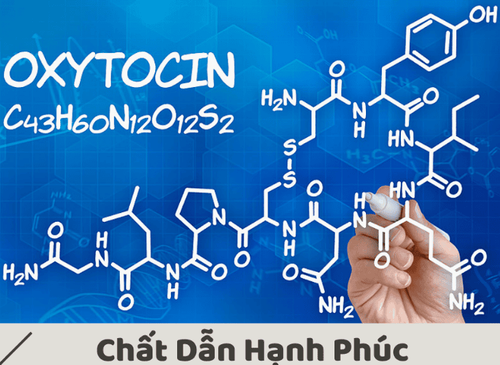This is an automatically translated article.
The article was professionally consulted by Specialist Doctor I Pham Thi Yen - Obstetrician - Obstetrics and Gynecology - Vinmec Hai Phong International General Hospital.Skin-to-skin contact after birth is currently the method used by experts because of many great benefits for the health and development of the baby. Besides, many parents share that skin-to-skin contact at birth is the most magical and happiest moment in life.
1. What is postpartum skin-to-skin contact?
The postpartum skin-to-skin contact method, also known as the Kangaroo method, is performed by placing the unclothed baby lying on the mother's bare chest or belly. There will be no distance between the mother and the baby when the baby's face, chest, abdomen and legs are close to the mother, and the baby's head is tilted to one side close to the mother.This method is ideally done 30 minutes to 1 hour after the baby is born, the umbilical cord pulse is still beating and repeated as many times as possible in the first week after birth. Besides skin-to-skin contact with the mother, the father can also perform skin-to-skin contact with the baby to strengthen the bond between the two fathers and children.
Under the guidance of the World Health Organization, the postpartum skin-to-skin contact method was started from a new program proposed by the Department of Maternal and Child Health of the Ministry of Health under Decision No. 4673/QD –BYT on 10/11/2014. From the fact that the infant mortality rate, especially in the first 3 days, is still very high, this program includes 6 steps as follows:
- Drying and warming before skin-to-skin contact
- Intramuscular injection 10 units of oxytocin
- Perform late clamping and cutting of the umbilical cord
- Controlled cord traction
- Perform fundus massage every 15 minutes within the first 2 hours postpartum

2. Why skin-to-skin after birth?
"Why skin-to-skin after birth?" will be the question of many parents when interested in this method. According to the World Health Organization (WHO), right after birth, the baby needs to be in contact with the mother's skin for at least an hour. Called the postpartum skin-to-skin contact method with the great benefits it brings. The reason is, the baby is getting used to the environment surrounded by the mother's amniotic fluid. The first few hours after birth must be a big shock for the baby. At this time, the mother's warm skin is close to the baby's skin, making it easier to get used to the environment.Making skin-to-skin contact is an effective way to connect motherhood and help baby's reflexes faster when she starts to breastfeed. Beyond these sacred emotions, there is a lot of evidence to support the great benefits of skin-to-skin contact between mother and child.
3. The amazing benefits of skin-to-skin contact after giving birth
Here are the benefits of skin-to-skin contact after birth for both mother and baby:Baby is warmed, stabilized body temperature, heart rate, breathing rate and blood sugar
Maintaining a baby's body temperature is very important. The sudden transition from the warm environment in the womb to the environment outside the temperature difference, plus the wet skin makes the baby's body very susceptible to cold. Instead, the mother's chest is the ideal position and is much warmer than other areas of the body, and the baby's first few minutes of skin-to-skin contact will be warm. One more important thing will help the baby reduce the need to produce energy to keep the body warm, breastfeed earlier, be healthier, avoid physiological pauses in breathing; make blood oxygen increase saturation; Helps regulate heart rate.Baby is less fussy
According to research, skin-to-skin contact between mother and baby within just 20 minutes has helped to reduce cortisol levels (a stress hormone) in the baby's body by 67-72%. Therefore, babies who are cared for in this way are often less fussy and less stressed.
Baby is optimally developed brain
Postpartum skin-to-skin contact is an experience that requires multi-sensory involvement. Thanks to this contact, the baby's body quickly develops neurotransmitters - which are especially necessary for the maturation of the brain.Furthermore, skin-to-skin contact also promotes the maturation of the amygdala (an important organ located deep in the center of the brain). These ganglia are involved in the process of forming emotions, promoting memory and activating the sympathetic nervous system. Also thanks to this method, the baby sleeps more deeply, which is one of the factors that help the baby develop comprehensively healthy.
Stimulates digestion and helps baby gain weight
Skin-to-skin contact with the baby after only 1 hour, the baby's digestive system will quickly be restored to a state of balance. Activating the vagus nerve, helps to increase the size of the microcapillaries in the lumen of the newborn baby's intestines. Increases intestinal surface area and improves nutrient absorption.Skin-to-skin contact also reduces the levels of cortisol and somatostatin (growth hormone inhibiting hormone) in the baby, facilitating the baby to absorb and digest food better and the baby will gain weight faster.
Improve immune system
Skin-to-skin contact after birth helps the baby absorb familiar bacteria from the mother's skin. Don't worry, because this is not dangerous because newborn babies receive antibodies against most of these bacteria while in the womb. Next, the mother's body will continue to produce antibodies against bacteria present in the environment. At this time, through breast milk antibodies are passed to the baby, helping to protect the baby from infections.Babies are breastfed early, milk comes in early and more often
Making skin-to-skin contact after birth increases the likelihood of finding the mother's milk source. Your baby will latch on more accurately and for longer. Research has also shown that breastfeeding rates are doubled if babies are given skin-to-skin contact right after birth instead of being tightly wrapped in diapers.Mothers who practice skin-to-skin contact from the start are more likely to continue breastfeeding when they get home. The growth of the mother's oxytocin and prolactin hormones in the early hours after birth helps to increase milk production in the long run. By practicing skin-to-skin contact for at least 60 minutes at a time, 1-2 times per day, mothers who are having trouble breastfeeding often get a lot of improvement.
Protecting baby from harmful effects of separation from mother
Research shows that babies separated from their mothers cry 10 times more often and cry for 40 times longer than babies who have skin-to-skin contact with their mothers. Heavy crying is often not good for the newborn baby and can affect lung function, increase intracranial pressure, increase stress hormones and directly affect the later emotional development of the baby. young. Therefore, skin-to-skin contact after birth is the recommended method to protect the baby against the harmful effects of separation from the mother.Skin-to-skin benefits after birth for mothers
When placed on the mother's bare chest, the baby is very close to the mother's milk supply. Baby can see and feel the nipple/areola, this has great attraction, encouraging baby to start suckling. Moreover, holding the baby in this way also stimulates the mother's body to release oxytocin. This is known as the "love hormone", oxytocin will help mothers feel relaxed, less anxious and closer to their babies.
Mother and baby have a lot of skin-to-skin contact and the more the baby suckles, the more oxytocin is secreted. This hormone leads to a series of positive changes for the mother: faster postpartum recovery time; reduce blood pressure in the body; the mother will have less anxiety, limit depression; milk about a lot; Uterine contractions reduce the risk of postpartum hemorrhage and quickly regain the slim waistline before pregnancy.
Skin-to-skin contact after birth helps to overcome all disadvantages when the baby is born by cesarean section. A caesarean section often leads to a number of consequences such as a later initiation of breastfeeding, a decrease in exclusive breastfeeding rates, and an increased risk of needing to supplement with formula.
Skin-to-skin contact can also be used in other situations, such as if you need to calm your baby's fussiness or hunger, or if your baby is a lazy sucker. The father can also help the mother hold the baby to perform skin-to-skin at any convenient time, many fathers said that they feel closer and closer to the baby when performing this method.
4. Importance of skin-to-skin contact at different times
0 - 90 minutes after birth: Very important for baby's brain development. 0 - 7 hours postpartum: Helps stabilize breathing and heart rate during the recovery period. 7 - 24 hours after birth: Help your baby form a regular breastfeeding schedule and sleep cycle. 12 hours - 8 weeks postpartum: Attaching more mother-child affection. Later mother-infant closeness cannot compensate for separation at birth.5. Scientific evidence of the benefits of skin-to-skin contact after giving birth
In 2012, according to the results of 34 trials in the US, the percentage of babies who were exclusively breastfed at 3-6 months was much higher in babies who had skin-to-skin contact after birth compared to those who were not. apply this way.Benefits for the mother:
Within a few days after giving birth, mothers often experience breast tenderness and discomfort. But when you do have skin-to-skin contact, you'll have less breast tenderness and less anxiety.
Benefits for the baby:
Baby sucks more milk.

Heart rate, breathing rate and body temperature are more stable.
Blood sugar in the body increases in a beneficial direction.
According to research to date, no harm has been found in relation to skin-to-skin contact. More importantly, the researchers found many risks associated with children being separated from their mothers after birth. When both healthy mother and baby are separated after birth, it reduces the chances of successful breastfeeding and increases the risk of breast engorgement and anxiety. The baby's breathing, heart rate, and blood sugar become unstable.
Thus, skin-to-skin contact after birth not only brings many great benefits to both mother and baby, but it is also the most sacred and memorable moment in the life of every parent. .
Vinmec International General Hospital offers a Package Maternity Care Program for pregnant women right from the first months of pregnancy with a full range of antenatal care visits, periodical 3D and 4D ultrasounds and routine tests to ensure that the mother is healthy and the fetus is developing comprehensively. Pregnant women will no longer be alone when entering labor because having a loved one to help them during childbirth always brings peace of mind and happiness.
Doctor Pham Thi Yen has 11 years of experience in examination and treatment in the field of Obstetrics and Gynecology. Doctor with strengths and deep understanding in:
Examination and consultation of normal pregnancies, pathological pregnancies, high-risk pregnancies Examination and treatment of gynecological diseases: cervicitis, cervical ectropion Surgery Laparoscopic surgery for gynecological diseases: ectopic pregnancy, uterine tumor, ovarian tumor Surgery for breast, vulvar, vaginal, cervical tumors Obstetric surgery: cesarean section, examination and treatment of endocrine disorders in women of all ages: puberty, reproductive age; perimenopausal age.
Please dial HOTLINE for more information or register for an appointment HERE. Download MyVinmec app to make appointments faster and to manage your bookings easily.














